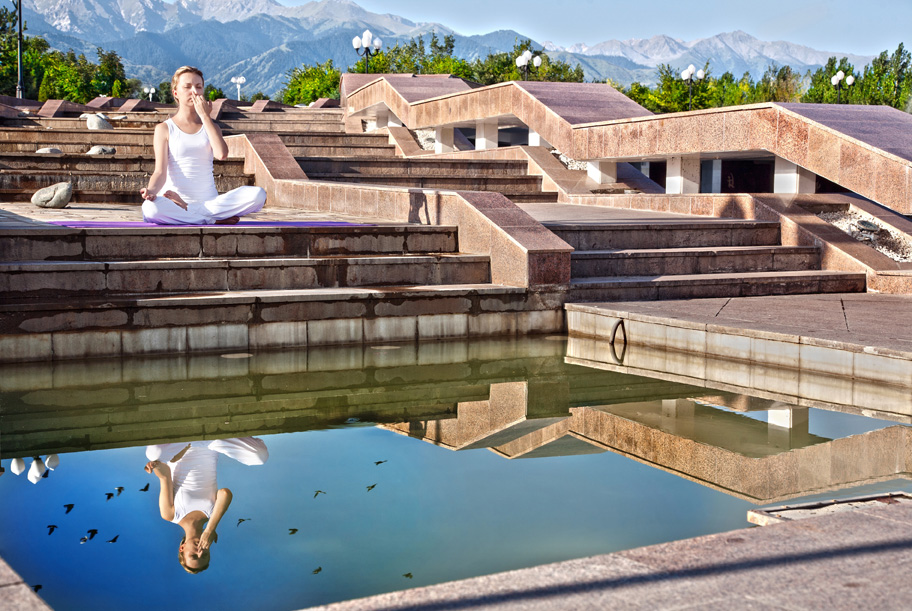
Summer vacation is timed with no coincidence – when the hot temperatures hit, we all need a break to stay calm and balanced. Yet for many of us, a long and soothing summer holiday is not a reality. Luckily, we can be the masters of fire with the help of Pranayama, or Yogic breathwork
How the elements in summer affect the human system
Summertime is known as the Pitta season according to Ayurveda. Pitta is one of the three Doshas, or humours in Ayurveda. Each Dosha is composed of a blend of the five elements. Pitta’s composition is mostly fire and a bit of water. The sun reaches its peak of exposure during this time, and we feel the resulting heat.
There is no inside or outside in Ayurveda. The elements in nature impact the ecosystem of the human system. Pitta will naturally increase in all individuals during Pitta season, and can potentially lead to excess Pitta Dosha as a result, which is a form of imbalance.
Excess Pitta Dosha may manifests as:
Irritability, quickness to anger
Acidity, nausea, indigestion
Infections, fever
Inflammation
Skin irritation such as oiliness, acne, blisters
Cooling the flames
Staying indoors with the air conditioning cranked is one method of staying balanced in terms of temperature, but it comes with its own side effects – dryness, excess coldness, to name the obvious. We also truly need nature’s therapy and outdoor air to maintain homeostasis. Enjoying the summertime outdoors requires some common sense – such as avoiding noontime peak heat, direct sun exposure, spicy foods, too much alcohol and other heating stimulants.
One of the best ways to calm the system of excess Pitta is through the power of breath. Before food and water, breath is the most important nutrient for our bodies. We take as many as 30,000 breaths per day, inhaling 1-2 gallons of air each minute. The air delivers needed oxygen to the system, as well as subtle energy, known as Prana, throughout the body. Every breath is an opportunity to shift our energy. Pranayama literally means “mind control” and is a vital component of Yoga for its power to regulate the mind-body system. The ancient Vedic text, Yoga Chudamani Upanisad states that there is no higher discipline than Pranayama. When breath is still, mind is still.
There are different techniques of breathwork to achieve specific results, including balancing of the three Doshas and temperature control. Three breathwork techniques in particular are helpful for balancing Pitta: Shitali, Sitkari and Nadi Shodhana.
The top three breath techniques for summertime
All of the following breathwork techniques are calming to the mind and emotions, which soothes Pitta Dosha.
Shitali
Shitali is a cooling breathe which is excellent for Pitta-dominant individuals or anyone experiencing excess Pitta. This technique involves a controlled inhalation through mouth and exhalation through the nostrils.
To perform this breath:
In a comfortable position, curl the tongue like the beak of a crow. While inhaling, suckle the air, creating the sound of bubbling water. Exhale through the nose.
Sitkari
This technique is a cooling Pranayama similar to Shitali, resulting in the release of excess heat.
To perform this breath:
The tip of the tongue is pressed to the root of the upper palette. When air is inhaled, it will naturally producing a hissing sound like a snake. Exhale through the nose.
Nadi Shodhana
Nadi Shodhana, or alternate nostril breathing can be used to balance all three Doshas: Vata, Pitta and Kapha. It is balancing to the brain’s blood flow, sympathetic and parasympathetic nervous system. Additionally, this breath clears the upper nasal passages and sinuses.
To perform this breath:
Using the right hand, block the left nostril with the ring finger. Inhale slowly and deeply through the right nostril. Then open the left nostril and close the right nostril with the thumb, exhaling slowly from the left nostril. Then inhale. Close the left nostril, exhale from the right nostril.
Note: if you experience hypertension or are pregnant, do not perform these techniques without consulting with your physician.
When to practice Pranayama
Traditionally, Pranayama was practiced after a Yoga asana practice of postures, typically in the early morning on an empty stomach. Asana prepares the body and mind for the stillness of Pranayama, which subsequently prepares the mind for meditation.
Introducing Pranayama as a morning ritual is an excellent way to start the day, though its benefits can be experienced throughout the day. You can bring these practices into your schedule whenever you can make time for yourself. Just be mindful of not practicing immediately after a meal. Pranayama practiced before eating will, in fact, assist in managing a balanced, healthy fire in the belly and peaceful mind for optimal digestion and assimilation.
There are immediate effects of Pranayama after a round of breaths, as well as long term effects, which may be felt with consistency.
Happy breathing.
About the author
-

Jamila is a certified Ayurvedic Wellness Counselor (AWC), Yoga Teacher (CYT) and Level I Reiki Practitioner. She earned her Bachelor of Arts (BA) in Literature & Journalism from New York University and channels her combined marketing skills, artistry and ancient wisdom to spread content seeds that elevate the attention economy, promote healing and radical planetary growth. In her dedication to...

